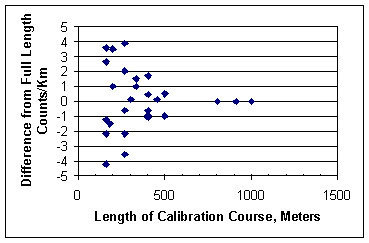The other day I was looking around for a site for a new calibration course near my home and found the necessary criteria very difficult to satisfy. (I do not live in Ohio!) The length of 300 meters was particularly difficult to find.
A length of 300 meters was established when the Jones counter was virtually the only one in use and the limit of readability of this is only one count or 0.05 rev. The recent use of the calibrated rim particularly with spoke intervals improves readability by a factor of ten. (The calibrated rim can be used with the Jones as well as with electronic counters.) I wondered if a shorter calibration course would give satisfactory results with a calibrated rim. Therefore, when I set up my new 300-meter course, I included a 100-meter mark. Calibrations done on my old 400-meter course and the new ones are shown below. (Spoke intervals were read from a 32-spoke wheel and no SCPF was applied. % difference is that from the old course.)
Crse,m--Rev----Ride1, si-------Ride2, si---------Rev/km---Cts/km--------%diff
400-----191------26.7-----------26.3-------------479.58---11335.5-------0.000
300-----143------27.5-----------28.2-------------479.57---11335.2-----neg0.003
100------47------31.3-----------31.0-------------479.77---11339.9--------0.039
Starting and stopping form a greater proportion of a 100-meter course than for longer courses, and there is probably a tendency as in the above test for the 100-meter course to produce a slightly longer calibration constant. I have an idea that this might be minimized by having the pedal at its highest point for push-off and by avoidance of coasting. In my test the constant from the shorter course was only greater than that from the others by about one third of the SCPF. Therefore in difficult situations the 100-meter calibration might be used.
Original Post












